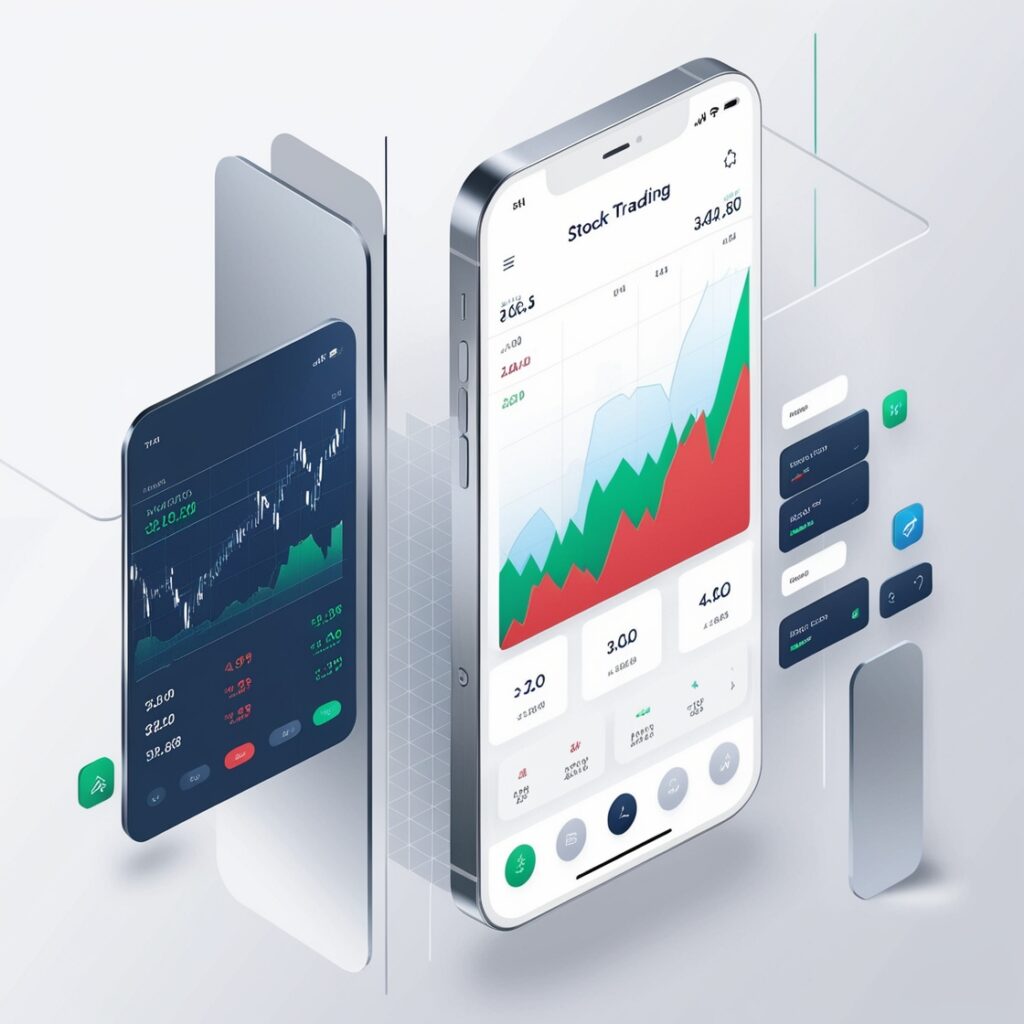The world of stock trading is thriving, and building your own stock trading app can open doors to exciting opportunities in the fintech space. With the rise of retail investors and online trading platforms, creating a stock trading app is not just a lucrative business idea but also a way to bring financial services to a wider audience. This guide will walk you through the steps to build a robust stock trading app while ensuring scalability, user-friendliness, and compliance.
Why Build a Stock Trading App?
Stock trading apps like Robinhood, eToro, and Webull have revolutionized how people invest in financial markets. Here’s why developing a stock trading app is a great idea:
1. Growing Market: Millions of users actively trade stocks, ETFs, and cryptocurrencies.
2. Convenience: Apps make trading accessible anywhere, anytime.
3. Monetization Opportunities: From transaction fees to premium features, there are multiple revenue streams.
Features to Include in Your Stock Trading App
When building a stock trading app, it’s essential to focus on features that enhance user experience and functionality:
1. User Authentication
• Secure login methods like two-factor authentication (2FA).
• KYC (Know Your Customer) verification for compliance.
2. Stock Market Data
• Real-time stock prices and market trends.
• Charts and analytics for informed decision-making.
3. Portfolio Management
• Track user investments and portfolio performance.
• Dividend and profit calculation.
4. Trade Execution
• Buy and sell stocks with minimal latency.
• Integration with brokerage APIs for seamless transactions.
5. Notifications
• Price alerts and important market news.
6. Educational Resources
• Tutorials and articles for beginner investors.
7. Payment Gateway
• Enable secure deposits and withdrawals.
Step-by-Step Guide to Building a Stock Trading App
Step 1: Research and Planning
Understand your target audience and the type of app you want to create (beginner-friendly, advanced trading, crypto-inclusive). Research competitors and decide on features to differentiate your stock trading app.
Step 2: Choose the Right Technology Stack
Selecting the right tools and technologies is critical for building a scalable and secure app:
• Frontend: React Native or Flutter for cross-platform compatibility.
• Backend: Node.js or Django for handling data requests and transactions.
• Database: PostgreSQL or MongoDB for storing user data.
• APIs: Use stock market APIs like Alpha Vantage, IEX Cloud, or Finnhub for real-time data.
Step 3: Design the User Interface (UI)
The UI is the first thing users interact with, so ensure it’s intuitive and visually appealing.
• Use light and dark modes for user preference.
• Include well-placed navigation for seamless user experience.
• Make charts interactive for advanced analysis.
Step 4: Integrate Stock Market Data
Stock market data is the backbone of any stock trading app. Use reliable APIs to provide:
• Real-time stock prices.
• Historical data for performance tracking.
• Market news and updates.
Step 5: Build Core Features
a. User Authentication
Secure the app with:
• OAuth for social logins.
• AES encryption for sensitive data.
b. Trade Execution
Integrate APIs from brokers like Alpaca, Interactive Brokers, or TD Ameritrade to enable real-time trading.
c. Portfolio Management
Develop dashboards to display:
• Current holdings.
• Gain/loss summaries.
d. Notifications
Use Firebase or OneSignal for sending push notifications about:
• Stock price movements.
• Market news.
Step 6: Ensure Compliance
A stock trading app must comply with financial regulations, including:
• SEC or FINRA in the U.S.
• GDPR for data protection in the EU.
• AML (Anti-Money Laundering) policies.
Step 7: Test for Performance and Security
Thoroughly test your app for:
• Latency during trade execution.
• Security vulnerabilities like SQL injection or unauthorized access.
Step 8: Launch and Scale
Deploy your app to the App Store and Google Play. Use marketing strategies like:
• Referral bonuses.
• Partnering with financial influencers.
Costs of Building a Stock Trading App
Building a stock trading app involves costs such as:
• Development: $25,000 to $100,000 depending on complexity.
• API Subscriptions: $100 to $500 per month.
• Compliance and Legal Fees: $10,000 to $50,000 annually.
Monetization Strategies
1. Transaction Fees: Charge per trade or withdrawal.
2. Premium Features: Advanced analytics or priority support.
3. Advertisements: Promote financial products or services.

Why Build a Stock Trading App?
The fintech industry has seen exponential growth in recent years. Apps like Robinhood, E*TRADE, and Webull have changed the way people interact with the stock market. By building a stock trading app, you can tap into a growing market and provide valuable tools for investors.
Key Benefits:
• Market Demand: Millions of users actively trade stocks, cryptocurrencies, and other assets online.
• Profit Potential: Revenue streams include trading fees, subscription plans, and ads.
• Empowering Users: Simplify trading for beginners and provide advanced tools for experts.
Key Features of a Stock Trading App
To attract and retain users, your stock trading app must have:
1. User Authentication and Security
• Multi-factor authentication (MFA).
• Secure data encryption for sensitive information.
2. Real-Time Market Data
• Real-time quotes for stocks, ETFs, and cryptocurrencies.
• Historical data and detailed market charts.
3. Customizable Watchlists
• Users can track their favorite stocks and receive updates.
4. Trading Execution
• Enable instant buying and selling of assets.
• Support limit and market orders.
5. Portfolio Management
• Real-time tracking of investments.
• Gain/loss insights and dividend tracking.
6. Push Notifications
• Alerts for stock price changes and market news.
• Notifications for portfolio performance updates.
7. Educational Resources
• In-app guides, videos, and tutorials for new investors.
Step-by-Step Guide to Building a Stock Trading App
Step 1: Understand Your Audience
Identify your target audience and define their needs:
• Beginners may need tutorials and simplified features.
• Experts require detailed charts and advanced trading tools.
Step 2: Choose the Right Technology Stack
Your tech stack determines the app’s performance and scalability.
Suggested Stack:
• Frontend: React Native for cross-platform compatibility.
• Backend: Node.js or Python (Django/Flask) for efficient server-side operations.
• Database: PostgreSQL or MongoDB for secure data storage.
• APIs: Use stock market data providers like Alpha Vantage, IEX Cloud, or Yahoo Finance.
Step 3: Design the User Interface (UI)
An intuitive design is crucial for a trading app. Consider:
• A clean layout with minimal distractions.
• Interactive charts and user-friendly navigation.
• Accessibility options like light and dark modes.
Use tools like Figma or Adobe XD to prototype your app’s design.
Step 4: Integrate Stock Market APIs
Stock market APIs provide the real-time data your app needs. Choose a reliable provider to ensure accurate information.
• Popular APIs:
• Alpha Vantage
• Finnhub
• Alpaca
Step 5: Build Core Functionalities
a. User Authentication
Secure your app with:
• OAuth for login via Google, Apple, or Facebook.
• End-to-end encryption for user data.
b. Real-Time Data Display
Fetch and display live market prices:
c. Trading Engine
Integrate with brokerage APIs like Alpaca or Tradier to execute trades.
d. Portfolio Management
Allow users to view and manage their investments:
• Track stock performance.
• Show percentage gain/loss.
Step 6: Ensure Compliance
Stock trading apps must adhere to financial regulations:
• SEC Compliance: Register your app with the SEC in the U.S.
• GDPR: Protect user data if targeting EU customers.
• AML (Anti-Money Laundering): Verify user identities.
Step 7: Test for Security and Performance
Test your app thoroughly:
• Security Testing: Prevent data breaches with penetration tests.
• Performance Testing: Ensure smooth operation during high traffic.

Step 8: Launch and Market Your App
Deploy your app on Google Play and the App Store. Promote it with:
• Social media campaigns.
• Referral bonuses for new users.
• Financial influencer partnerships.
Challenges in Building a Stock Trading App
1. Real-Time Data Latency:
Ensure low-latency data updates to provide accurate stock prices.
2. High Security Standards:
Protect sensitive user data with encryption and secure API endpoints.
3. Compliance Overhead:
Meeting regulatory requirements can be time-consuming and expensive.
Monetization Strategies
Monetize your stock trading app with these methods:
1. Transaction Fees: Charge a small fee for each trade.
2. Premium Features: Offer advanced analytics and trading tools via subscription.
3. In-App Ads: Partner with financial service providers for ad revenue.
Conclusion
Building a stock trading app is a rewarding but complex process. By focusing on features like real-time data, portfolio management, and user-friendly design, you can create an app that meets user needs and stands out in the fintech market.
Start today and make your mark in the fast-growing world of stock trading technology!




Your point of view caught my eye and was very interesting. Thanks. I have a question for you.
Thank you for your sharing. I am worried that I lack creative ideas. It is your article that makes me full of hope. Thank you. But, I have a question, can you help me?
Thanks for sharing. I read many of your blog posts, cool, your blog is very good.
Your article helped me a lot, is there any more related content? Thanks!
Thanks for sharing. I read many of your blog posts, cool, your blog is very good. https://accounts.binance.info/register?ref=P9L9FQKY